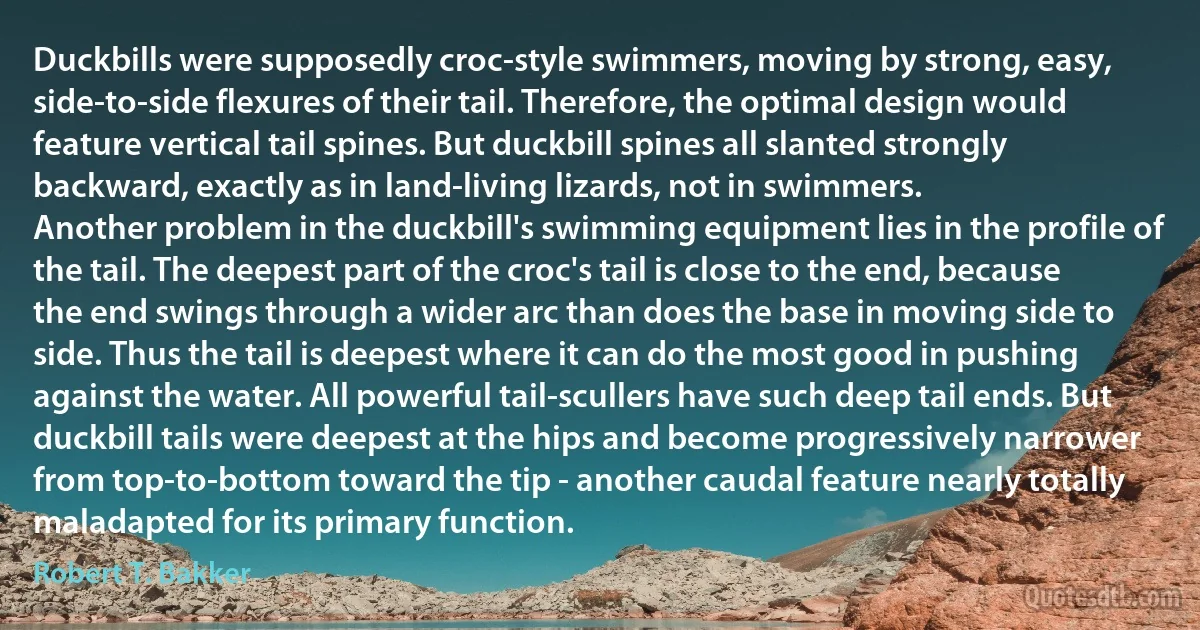
Duckbills were supposedly croc-style swimmers, moving by strong, easy, side-to-side flexures of their tail. Therefore, the optimal design would feature vertical tail spines. But duckbill spines all slanted strongly backward, exactly as in land-living lizards, not in swimmers. Another problem in the duckbill's swimming equipment lies in the profile of the tail. The deepest part of the croc's tail is close to the end, because the end swings through a wider arc than does the base in moving side to side. Thus the tail is deepest where it can do the most good in pushing against the water. All powerful tail-scullers have such deep tail ends. But duckbill tails were deepest at the hips and become progressively narrower from top-to-bottom toward the tip - another caudal feature nearly totally maladapted for its primary function.
Robert T. BakkerRelated topics
base close deep easy end equipment feature good moving primary problem profile side tail thus tip vertical water lies ends optimalRelated quotes
Don't forget that God sees you and watches you when you are in pain; He perceives even the beating of your heart. Consequently, He will not leave you without consolation and His fatherly protection. Naturally, the saints rejoiced in their afflictions; as for us, let us at least manage to accept affliction or pain patiently.
My child, pray within your heart, and the name of Jesus will become for you a comforting balm so that you can bear this trial of yours in a way which benefits you. You will greatly benefit from this trial if you submit yourself to it patiently. So again I say to you, with the almighty armor of prayer continually approach the omnipotent Lord more often, and you will come to know how He wondrously lifts the burden of pain and marvellously gives rest to sufferers.

Ephraim of Arizona
Whether it be generally recognized or not, what we call the civilized world, which for seven hundred years has been moving steadily forward in the spirit of liberalism and toward liberalism s high ideals, has now turned suddenly and violently backward. The guidance of reason and of understanding, of moral principle and of religious faith, has been shockingly and cruelly disslaced by the rule of brute force. Our literally stupendous achievements in literature, in philosophy, in the arts, in the sciences and in the comforts and conveniences of life count for nothing in the control of no national policy and of national conduct, and by far the major portion of the world is now under the rule of brutal compulsion. Such portion of the world as is not in that condition may soon be struggling for its life.

Nicholas Murray Butler
Thus it was that America sank further and further into Americanism. Vast wealth and industry, and also brilliant invention, were concentrated upon puerile ends. In particular the whole of American life was organized around the cult of the powerful individual, that phantom ideal which Europe herself had only begun to outgrow in her last phase. Those Americans who wholly failed to realize this ideal, who remained at the bottom of the social ladder, either consoled themselves with hopes for the future, or stole symbolical satisfaction by identifying themselves with some popular star, or gloated upon their American citizenship, and applauded the arrogant foreign policy of their government. Those who achieved power were satisfied so long as they could merely retain it, and advertise it uncritically in the conventionally self-assertive manners.

Olaf Stapledon
The mirror by the door was not a mirror by the door, it was an altar where he stood for only a moment to put on his cap before going out. The red rocking chair was a rocking of his own hips as he sat in the kitchen. Still, there was nothing of his - his own - that she could find. It was as if she were afraid she had hallucinated him and needed proof to the contrary. His absence was everywhere, stinging everything, giving the furnishings primary colors, sharp outlines to the corners of rooms and gold light to the dust collecting on table tops. When he was there he pulled everything toward himself. Not only her eyes and all her senses but also inanimate things seemed to exist because of him, backdrops to his presence. Now that he had gone, these things, so long subdued by his presence, were glamorized in his wake.

Toni Morrison
We don't have much time left. We are moving towards temperature increases of around two degrees Celsius, which is going to have consequences in the tropics, and we will loose things like glaciers. That's not a theory; it's happening right now. It's not a prediction; it's happening right now. But you just sightsee near those glaciers. But the glaciers are a big source of water. And on the questions of water, in California we store our water in a snowpack. When that's gone, the rain will be the same but it won't accumulate. With warming temperatures the snowpack will now work. It might be possible to substitute with dams, but that's complicated. This is conjoined with a big energy problem and I think that we really have to encourage development in this area. Just waiting for technological improvement won't work. We need to encourage it.

Kenneth Arrow
